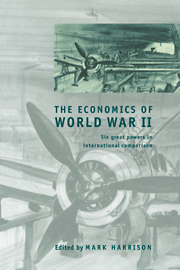Book contents
- Frontmatter
- Contents
- List of figures
- List of tables
- List of contributors
- Preface
- List of abbreviations
- 1 The economics of World War II: an overview
- 2 The United Kingdom: ‘Victory at all costs’
- 3 The United States: from ploughshares to swords
- 4 Germany: guns, butter, and economic miracles
- 5 Italy: how to lose the war and win the peace
- 6 Japan: guns before rice
- 7 The Soviet Union: the defeated victor
- Index
5 - Italy: how to lose the war and win the peace
Published online by Cambridge University Press: 12 September 2009
- Frontmatter
- Contents
- List of figures
- List of tables
- List of contributors
- Preface
- List of abbreviations
- 1 The economics of World War II: an overview
- 2 The United Kingdom: ‘Victory at all costs’
- 3 The United States: from ploughshares to swords
- 4 Germany: guns, butter, and economic miracles
- 5 Italy: how to lose the war and win the peace
- 6 Japan: guns before rice
- 7 The Soviet Union: the defeated victor
- Index
Summary
Introduction
Two world wars cut across Italian industrialization in the crucial decades immediately following the country's take-off. During World War I, some Italian industrial firms became large enough to place Italy within the small number of countries having technologically advanced industrial firms. But it was very difficult for such firms to survive in peacetime, during the troubled 1920s and the even more difficult 1930s, so that the Italian state had to engage in substantial bailing-out operations by the end of which many of the country's largest firms had become publicly owned, including some banks. During World War II, the existing firms (plus a few newly created ones) were strengthened and further enlarged through public spending on munitions.
This chapter will try to explain why the level of development reached by Italy before and during the war did not allow the country to fight the war decently, let alone win it, but also how Italy's engaging in the war ended by strengthening Italian industrial technology in such a way as to allow the ensuing ‘economic miracle’ to take place. I certainly do not want to argue that Italy could only have deepened her industrialization through the war nor that this was the best way of doing so, but rather that, given the political inevitability of war, Italy developed plans of industrialization through the war that were conducive to the subsequent sustained economic development.
- Type
- Chapter
- Information
- The Economics of World War IISix Great Powers in International Comparison, pp. 177 - 223Publisher: Cambridge University PressPrint publication year: 1998
- 3
- Cited by



